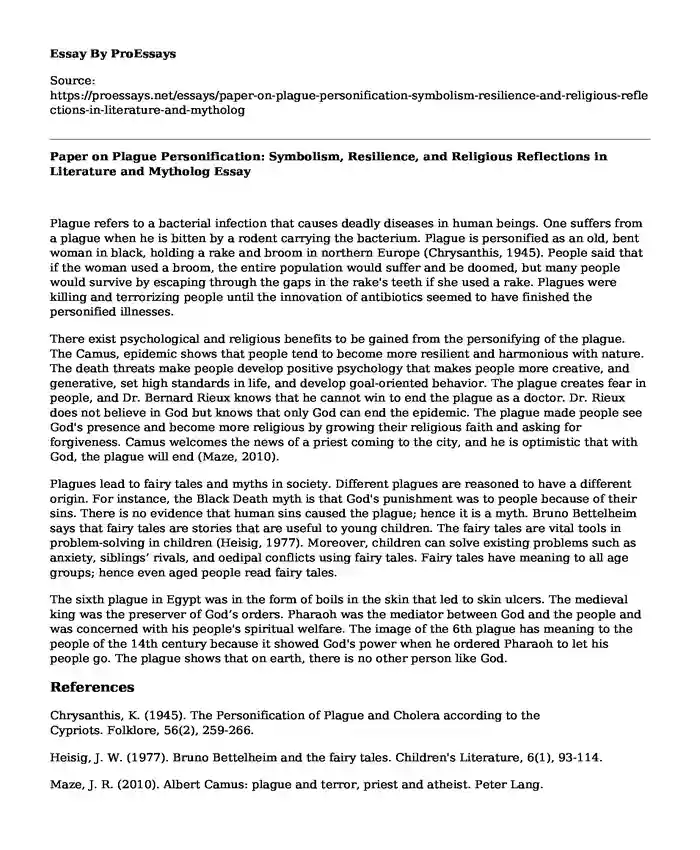Plague refers to a bacterial infection that causes deadly diseases in human beings. One suffers from a plague when he is bitten by a rodent carrying the bacterium. Plague is personified as an old, bent woman in black, holding a rake and broom in northern Europe (Chrysanthis, 1945). People said that if the woman used a broom, the entire population would suffer and be doomed, but many people would survive by escaping through the gaps in the rake's teeth if she used a rake. Plagues were killing and terrorizing people until the innovation of antibiotics seemed to have finished the personified illnesses.
There exist psychological and religious benefits to be gained from the personifying of the plague. The Camus, epidemic shows that people tend to become more resilient and harmonious with nature. The death threats make people develop positive psychology that makes people more creative, and generative, set high standards in life, and develop goal-oriented behavior. The plague creates fear in people, and Dr. Bernard Rieux knows that he cannot win to end the plague as a doctor. Dr. Rieux does not believe in God but knows that only God can end the epidemic. The plague made people see God's presence and become more religious by growing their religious faith and asking for forgiveness. Camus welcomes the news of a priest coming to the city, and he is optimistic that with God, the plague will end (Maze, 2010).
Plagues lead to fairy tales and myths in society. Different plagues are reasoned to have a different origin. For instance, the Black Death myth is that God's punishment was to people because of their sins. There is no evidence that human sins caused the plague; hence it is a myth. Bruno Bettelheim says that fairy tales are stories that are useful to young children. The fairy tales are vital tools in problem-solving in children (Heisig, 1977). Moreover, children can solve existing problems such as anxiety, siblings’ rivals, and oedipal conflicts using fairy tales. Fairy tales have meaning to all age groups; hence even aged people read fairy tales.
The sixth plague in Egypt was in the form of boils in the skin that led to skin ulcers. The medieval king was the preserver of God’s orders. Pharaoh was the mediator between God and the people and was concerned with his people's spiritual welfare. The image of the 6th plague has meaning to the people of the 14th century because it showed God's power when he ordered Pharaoh to let his people go. The plague shows that on earth, there is no other person like God.
References
Chrysanthis, K. (1945). The Personification of Plague and Cholera according to the Cypriots. Folklore, 56(2), 259-266.
Heisig, J. W. (1977). Bruno Bettelheim and the fairy tales. Children's Literature, 6(1), 93-114.
Maze, J. R. (2010). Albert Camus: plague and terror, priest and atheist. Peter Lang.
Cite this page
Paper on Plague Personification: Symbolism, Resilience, and Religious Reflections in Literature and Mytholog. (2023, Dec 13). Retrieved from https://proessays.net/essays/paper-on-plague-personification-symbolism-resilience-and-religious-reflections-in-literature-and-mytholog
If you are the original author of this essay and no longer wish to have it published on the ProEssays website, please click below to request its removal:
- Practical Nursing Essay Example
- Questions on Epidemiology Paper Example
- Endocrine Disorders and Diabetes - Essay Sample
- The Rohingya Community Essay Example
- Smoking Is Affecting Your Health in a Negative Way Speech Paper Example
- Research Paper on Euthanasia: An Ethical Issue that Divides Societies
- Essay Example on NGO Resources: How Boards Manage for Needy Groups







